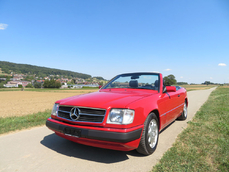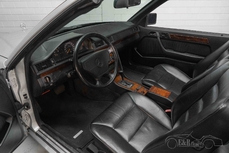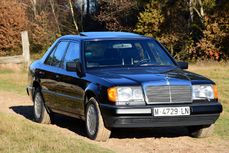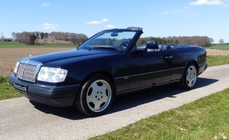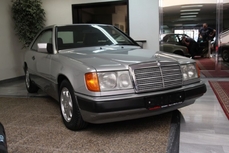Mercedes-Benz 300 w124 3.0L I6 1990
General description :
A good Benz sedan always gains a lot of interest. After all, they were built for the long run, and they are often exceptionally maintained. Such is the case with this 1990 Mercedes-Benz 300E. It's clean, complete, premium, and offers just the right upgrades to keep it a worthwhile classic cruiser in the modern age.
The W124 generation of Mercedes sedans represents the new face of a true vintage Benz. It gives us the classic grille that has stood for decades but in an overall more streamlined package. It's as timelessly fashionable as an upright German businessman who looks sharp in his gray three-piece suit, and it has that hint of something extra, like as if he put on the boldest red tie he can find. That's why this one also looks so good in its factory Pearl Gray. It has the crisp and clean look we want from a precision-built machine, and there are even some updated 15-inch alloys for added flair.
The light gray leather interior continues the sharp-dressed businessman idea. It looks premium, clean, and exceptionally well-kept for its age. So you really can tell just by the first impression that this is a well-respected Mercedes. One of the reasons for a car to be kept at such upper-class level is because it has upper-class amenities. You have a power sunroof, power windows, power locks, power mirrors, and automatic A/C climate control. The stereo has even been upgraded to a modern AM/FM/CD unit with Bluetooth and a screen for the back-up camera. These were built to be a true driver's machine. That's why the front seat not only power adjusts, but also yours remembers your ideal driving position. There's a wide comfy armrest, grippy steering wheel w/airbag, tilt telescoping column, and crisp VDO gauges. So it's easy to get comfortable even for the long haul.
The 3.0-liter fuel-injected inline-six is believed to be original to the car, and it has a well-kept look. In fact, this has been given some nice investments within the last couple of years, including a new water pump, belt tensioner, EHA valve. It fires up readily and drives with confidence like a proper Benz should. New shocks and struts give this a solid feeling on the road. There are also all the right easy driving features, like power steering, four-wheel power disc brakes w/ABS, and a fully independent suspension. And the four-speed automatic transmission w/overdrive and cruise control mean this is the vintage car that's even ready for long distance cruising.
The sale comes complete with owner's manual packet and maintenance records. This is the kind of clean, confident, and premium Mercedes you've always wanted, and the price will likely never be better for a well-respected example like this. Call today!!!
https://www.streetsideclassics.com/vehicles/5548-atl/1990-mercedes-benz-300e
1990 Mercedes-Benz 300 w124 3.0L I6 is listed sold on ClassicDigest in Lithia Springs by Streetside Classics for Not priced.
Car Facts
Car type : Car Make : Mercedes-Benz Model : 300 w124 Model Version : 3.0L I6 Engine size : 3.0 Model Year : 1990 Location : Atlanta
Sold
Seller Information
Sold
People who viewed this Mercedes-Benz 300 w124 also viewed similar Mercedes-Benz listed at ClassicDigest
About Mercedes-Benz
In the annals of automotive history, the journey of Mercedes-Benz is a tale that unfolds with the ingenuity of its founding pioneers. In the year 1886, Karl Benz crafted the Benz Patent Motorwagen, a creation that would go down in history as the world's inaugural automobile. Unbeknownst to him, this moment marked the genesis of what would evolve into the most illustrious premium car manufacturer globally. The financial underpinning of this pioneering venture, interestingly, was provided by Karl Benz's wife, Bertha Benz, demonstrating a remarkable partnership that would set the tone for Mercedes-Benz's legacy.A parallel narrative emerged not far away, as Daimler-Motoren-Gesellschaft, founded by Gottlieb Daimler and Wilhelm Maybach, entered the scene. In 1901, they unveiled their automobile under the now-famous moniker "Mercedes," meaning "godsend" in Spanish. This name was bestowed upon the car at the behest of Emil Jellinek's daughter, the distributor for Daimler-Motoren-Gesellschaft. The wheels of innovation were set in motion.
Fast forward to 1926, a pivotal year that witnessed the merger of Daimler with Benz & Cie., culminating in the birth of Daimler-Benz. The amalgamation saw the adoption of "Mercedes-Benz" as the distinguished trademark for their automobiles, fusing the legacies of two visionary entities into one.
Contrary to perceptions of conservatism, the trajectory of Daimler-Benz unfolds as a chronicle of industry firsts. From the introduction of the honeycomb radiator to the float carburetor, and the pioneering implementation of four-wheel brakes in 1924, Daimler-Benz consistently pushed the boundaries of automotive innovation. The diesel-powered Mercedes-Benz 260 D in 1936 marked the inception of diesel engines in passenger cars. The iconic Mercedes-Benz 300SL Gullwing made history as the first car with direct fuel injection, albeit the Gutbrod's tiny 2-stroke engine can claim precedence.
Safety innovations became a hallmark, with Béla Barényi's patented safety cell design in the "Ponton"-models in 1951, featuring front and rear crumple zones. The W116 450SEL 6.9 saw the introduction of the Anti-Lock Brake system (ABS), another pioneering safety feature. From the first production airbags and beyond, the legacy of "firsts" continued to be etched into the fabric of Daimler-Benz.
Over its centennial journey, Mercedes-Benz has not merely produced cars but has sculpted automotive icons. The SSKL, 710 SSK Trossi Roadster, 770K Grosser, 540K Spezial Roadster, 300SL Gullwing, w100 600 Pullman, w111 280SE 3.5 Flachkühler, w113 230SL Pagoda, w109 300 SEL 6.3, and w201 2.3-16 Cosworth stand testament to the brand's commitment to engineering excellence.
The roaring Silver Arrows, or "Silberpfeile," including the W 25, W 125, W154, W165, and W196, created a legacy of dominance on the racetrack. These machines were not merely cars; they were expressions of precision, speed, and an indomitable spirit that left their competitors in the dust.
As Mercedes-Benz marches into the future, it does so not just as an automaker but as a custodian of a legacy, a torchbearer of innovation, and a beacon of automotive excellence. The road ahead is sure to witness the continued fusion of cutting-edge technology, timeless design, and an unwavering commitment to setting new standards in the world of automobiles.
One luminary figure who left an indelible mark was Béla Barényi, often heralded as the "father of passive safety" for his pioneering work in safety engineering. His patented safety cell design, featuring front and rear crumple zones, became a hallmark of Mercedes-Benz's commitment to occupant safety, setting new standards that reverberated throughout the automotive world.
Moving through the chronicles, the collaborative genius of Wilhelm Maybach, alongside Gottlieb Daimler, laid the foundation for Daimler-Motoren-Gesellschaft. Their innovations not only birthed the first Mercedes but established a culture of relentless pursuit of technological excellence that remains integral to Mercedes-Benz's DNA.
In the post-merger era of 1926, Ferdinand Porsche emerged as a prominent figure within Mercedes-Benz. His work on the Mercedes-Benz S-Type, a supercharged race car, garnered acclaim and set the stage for a legacy that extended far beyond the marque. Porsche's impact would later extend to his eponymous company, but his influence at Mercedes-Benz during those formative years was pivotal.
As the 20th century progressed, the legendary Rudolf Uhlenhaut emerged as a key figure. Uhlenhaut, an accomplished engineer and the driving force behind the iconic Silver Arrows, played a crucial role in Mercedes-Benz's dominance in motorsports. His engineering prowess and attention to detail were instrumental in creating some of the most formidable racing cars of the era.
In the latter half of the century, figures like Bruno Sacco, the head of design at Mercedes-Benz from 1975 to 1999, left an indelible imprint on the brand's aesthetic identity. Sacco's design philosophy, characterized by clean lines and timeless elegance, shaped iconic models like the W126 S-Class and the W201 190E, solidifying Mercedes-Benz's reputation for luxury and sophistication.
The narrative would be incomplete without acknowledging the contributions of engineers like Hans Scherenberg, whose leadership in the 1970s ushered in a new era of technological innovation at Mercedes-Benz. Scherenberg's tenure saw the development of groundbreaking technologies, including the Anti-Lock Brake system (ABS) and the introduction of airbags in production cars.
















